|
|
|
Sort Order |
|
|
|
Items / Page
|
|
|
|
|
|
|
| Srl | Item |
| 1 |
ID:
176056
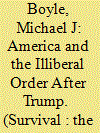

|
|
|
|
|
| Summary/Abstract |
The US will not be able to manage a long-term ideological struggle unless it addresses illiberalism in its own political institutions.
|
|
|
|
|
|
|
|
|
|
|
|
|
|
|
|
| 2 |
ID:
087767
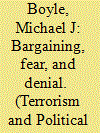

|
|
|
|
|
| Publication |
2009.
|
| Summary/Abstract |
From mid-2004 to mid-2007, the Iraq war was distinguished from other comparable insurgencies by its high rates of civilian victimization. This has been attributed to a number of different factors, including the role of Islamic fundamentalist groups such as al-Qaeda in Iraq as well as the regional ambitions of Iran and Syria. Using an unpublished dataset of violence in Iraq from 2003-2008 from the Iraq Body Count (IBC), this paper argues that the violence against civilians is best understood as a combination of three interacting logics-bargaining, fear, and denial-that are predominantly local in character. First, armed Iraqi actors bargained through violence both across and within sectarian communities, and were driven by mechanisms of outbidding and outflanking to escalate their attacks on civilians. Second, the pervasive fear about the future of the Iraqi state encouraged the "localization" of violence in Iraq, particularly in the emergence of a security dilemma and the proliferation of criminal and tribal actors. Finally, Islamist groups such as al-Qaeda in Iraq played the spoiler in Iraq, using mass-casualty attacks to generate fear among the population and deny U.S. efforts to build a functioning state. Only by addressing each of these three logics as part of its counter-insurgency strategy can the U.S. put an end to violence against civilians and develop the Iraqi state into a credible competitor for the loyalties of the population.
|
|
|
|
|
|
|
|
|
|
|
|
|
|
|
|
| 3 |
ID:
105372
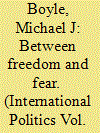

|
|
|
|
|
| Publication |
2011.
|
| Summary/Abstract |
Why have two successive US administrations concluded that fighting terrorism must involve democracy promotion? This assumption became prevalent in US political discourse following the events of September 11 despite the fact that the empirical evidence linking democracy and terrorism is weak or ambiguous. More strikingly, it has persisted even after the missions to establish democracies in Afghanistan and Iraq have led to increasing violence, including a worldwide increase in terrorist attacks. This article argues that the link between democracy and terrorism was established by the combined effect of three factors: (a) the framing of the September 11 attacks in a way that increased the receptivity to this conceptual opposition between freedom and fear; (b) the ideological influence of the Wilsonian tradition, as manifested today in an unusual consensus between modern neo-conservatives and liberal internationalists on the desirability of democratic reform as a means of changing foreign policy behaviour; and (c) a powerful bipartisan domestic constituency in favour of democracy promotion. Owing to these three factors, the contraposition of democracy and terrorism in American political discourse is effectively over-determined because it mirrors the dominant ideological and political preferences of American elites. This fixed preference for democracy promotion explains why the Obama Administration has remained wedded to the binary distinction between freedom and fear in its public statements despite its efforts to break in style and substance with the policies of its predecessor.
|
|
|
|
|
|
|
|
|
|
|
|
|
|
|
|
| 4 |
ID:
144104
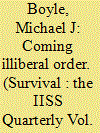

|
|
|
|
|
| Summary/Abstract |
In a July 2014 speech in Băile Tuşnad, Romania, recently re-elected Hungarian Prime Minister Viktor Orbán declared that it was time for Hungary to ‘abandon liberal methods and principles of organizing society’ and to embark upon a project of building a new ‘illiberal state’. Citing China, Russia, Singapore, India and Turkey as models, Orbán argued that the liberal-democratic model had performed poorly compared to authoritarian states and illiberal democracies during the financial crisis in 2008. Throughout that crisis, he noted, it was illiberal states – as he put it, ‘systems that are not Western, not liberal, not liberal democracies, maybe not even democracies’ – which proved more successful in responding to global economic turmoil. While he acknowledged that liberal values retained a degree of attractiveness, Orbán argued that it was important for states to cut themselves loose of the legal restrictions imposed by liberal democracy and to engage in a new type of economic nationalism to ensure that their interests were protected in the global economy.
|
|
|
|
|
|
|
|
|
|
|
|
|
|
|
|
| 5 |
ID:
119436
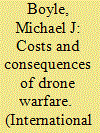

|
|
|
|
|
| Publication |
2013.
|
| Summary/Abstract |
One of the distinctive elements of President Barack Obama's approach to counterterrorism has been his embrace of Unmanned Aerial Vehicles (UAVs), or drones, to target terrorist operatives abroad. The Obama administration has used drones in active theatres of war, such as Afghanistan, but it has also dramatically increased the number of drone attacks launched by the CIA in other countries, such as Pakistan, Yemen and Somalia. The conventional wisdom on drone warfare holds that these weapons are highly effective in killing terrorist operatives and disabling terrorist organizations, while killing fewer civilians than other means of attack.
This article argues that much of the existing debate on drones operates with an attenuated notion of effectiveness that discounts the political and strategic dynamics - such as the corrosion of the perceptions of competence and legitimacy of governments where drone strikes take place, growing anti-Americanism and fresh recruitment of militant networks - that reveal the costs of drone warfare. Focusing particularly on drone use in Pakistan, Yemen and Somalia, the article suggests that the Obama administration's counterterrorism policy operates at cross-purposes because it provides a steady flow of arms and financial resources to build up governments whose legitimacy it systematically undermines by conducting unilateral strikes on their territory.
It concludes that the US embrace of drone technology is a losing proposition over the long term as it will usher in a new arms race and lay the foundations for an international system that is increasingly violent, destabilized and polarized between those who have drones and those who are victims of them.
|
|
|
|
|
|
|
|
|
|
|
|
|
|
|
|
| 6 |
ID:
188123


|
|
|
|
|
| Summary/Abstract |
How should the United States recalibrate its counterterrorism policy for an era of great power competition? With the end of unipolarity, the United States cannot fight terrorists and compete with Russia and China with equal energy, but must instead make hard choices about its priorities and resources. Among those hard choices are what to do with the web of counterterrorism partnerships with other governments that have formed in the post- 9/11 era. This article proposes three broad principles—linkages, license, and legitimacy—that the United States can use to evaluate its policy and these partnerships, with the aim of recasting U.S. counterterrorism policy for an era of great power competition.
|
|
|
|
|
|
|
|
|
|
|
|
|
|
|
|
| 7 |
ID:
095064
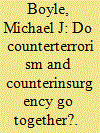

|
|
|
|
|
| Publication |
2010.
|
| Summary/Abstract |
One of the underlying assumptions of the contemporary debate over Afghanistan is that counterterrorism objectives can be achieved through counterinsurgency methods. The recent decision by President Barack Obama to deploy 30,000 extra troops to Afghanistan is premised on the idea that to disrupt Al Qaeda and prevent it from forming training camps in Afghanistan it will be necessary to first reverse the momentum of the Taleban insurgency. This approach-which places the US and UK on the offensive to disrupt terrorist plots before they arrive on their shores-assumes that the threats from Al Qaeda and the Taleban are intertwined and thus the strategy of response must seamlessly comprise elements of counterterrorism and counterinsurgency. In fact, counterterrorism and counterinsurgency are very different-often contradictory-models of warfare, each with its own associated assumptions regarding the role of force, the importance of winning support among the local population, and the necessity of building strong and representative government. Rather than being mutually reinforcing, they may impose tradeoffs on each other, as counterterrorism activities may blunt the effectiveness of counterinsurgency approaches and vice versa. The last four years in Afghanistan provide evidence that when employed in the same theatre counterterrorism and counterinsurgency strategies can offset one another. To be in a position to begin the withdrawal of US troops before July 2011, the Obama administration will need to find a way to manage the tradeoffs between its counterterrorism and counterinsurgency strategies in Afghanistan.
|
|
|
|
|
|
|
|
|
|
|
|
|
|
|
|
| 8 |
ID:
087395
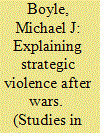

|
|
|
|
|
| Publication |
2009.
|
| Summary/Abstract |
This article aims to explain why strategic violence against targeted groups emerges after some civil wars but not others. It argues that when one side has captured the coercive apparatus of the state, and the potentially hostile losing side is less vulnerable to predation, the leaders of the victorious group can reward their domestic constituents and conduct in-group policing to prevent opportunistic violence. But when an armed group fails to achieve state capture and the losing side remains in a vulnerable position relative to its former enemies, neither side can credibly guarantee their domestic allies a share of the resources of the state or conduct effective in-group policing of potential extremists. Using Kosovo and East Timor as case studies, this article shows that in these cases, strategic violence is less a function of a concerted attempt to spoil a settlement than of the internal bargaining of new splinter groups.
|
|
|
|
|
|
|
|
|
|
|
|
|
|
|
|
| 9 |
ID:
129650
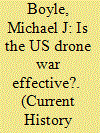

|
|
|
|
|
| Publication |
2014.
|
| Summary/Abstract |
Among the most distinctive features of US President Barack Obama's counterterrorism strategy has been his reliance on unmanned aerial vehicles-more commonly known as drones-to target terrorist operatives around the globe. The use of drones has rapidly expanded beyond the battlefields where US troops have openly engaged in conflict, such as Afghanistan and Iraq, to a range of undeclared combat zones, including Pakistan, Yemen, and Somalia. According to an official estimate, the US military launched in 1,160 drone strikes in Afghanistan alone between 2009 and 2012.
|
|
|
|
|
|
|
|
|
|
|
|
|
|
|
|
| 10 |
ID:
114671
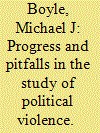

|
|
|
|
|
| Publication |
2012.
|
| Summary/Abstract |
The study of political violence has undergone dramatic changes in its orientation, scope, and empirical approach over the last twenty years. The increasing availability of micro-level data and the growing methodological sophistication of researchers have led to a proliferation of high quality studies on different types of political violence, such as genocide, ethnic cleansing, inter-state war, insurgency, civil war, and repression. However, the cost of this increased sophistication has been fragmentation of the field into highly specialized studies of types of political violence, themselves often divided by theoretical assumptions and methodological approaches. As a way of encouraging the cross-pollination of ideas across the study of political violence, this special edition has asked leading scholars in the field to produce "state of the field" survey pieces on each type of political violence and to identify directions for future research. This introduction lays out the rationale for this special edition, highlights some of the key themes and findings in the included articles, and identifies several insights from this literature that will also be applicable to the study of terrorism.
|
|
|
|
|
|
|
|
|
|
|
|
|
|
|
|
| 11 |
ID:
148068
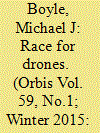

|
|
|
|
|
| Summary/Abstract |
In just the last ten years, a growing number of states have sought to join the race to develop and sell ever-more sophisticated drones on the global market. While today the market remains stratified between makers and takers of drones, the gradual emergence of a drones arms race will have some important and potentially dangerous consequences for the international system. The emergence of a race for drones will reshape long-simmering conflicts and rivalries around the world in three ways. First, the proliferation of drones will reset the rules and norms governing surveillance and reconnaissance. Second, drones will become increasingly useful to governments in testing the strategic commitments and the nerves of their rivals. Third, the worldwide proliferation of drones will multiply the risks of conflict spirals stemming from accidents or hijacked drones. Given these risks, Washington’ should take a leading role in slowing the global race for drones and in developing strict legal and normative mechanisms to govern drone usage and sales in the future.
|
|
|
|
|
|
|
|
|
|
|
|
|
|
|
|
| 12 |
ID:
149072
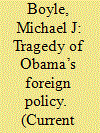

|
|
|
|
|
| Summary/Abstract |
Historians may well conclude that Obama glimpsed a different world for American foreign policy but never exerted the kind of strategic direction needed to turn that vision into reality.
|
|
|
|
|
|
|
|
|
|
|
|
|
|
|
|
| 13 |
ID:
081384
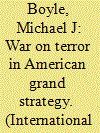

|
|
|
|
|
| Publication |
2008.
|
| Summary/Abstract |
The 9/11 attacks made the war on terror the central plank of American grand strategy. Yet despite its importance in shaping US policy choices, there has been considerable confusion over how the war on terror relates to foreign policy goals. This article attempts to locate the war on terror within American grand strategy and makes three claims. First, it argues that the Bush administration's approach to the war on terror rests on a false analogy between terrorism and fascism or communism. This has led to misinterpretations of the goals of the war on terror and to a persistent misuse of American power. Second, it suggests that the central purpose of the war on terror should be to de-legitimize terror as a tactic and to induce states to assume responsibility for controlling terrorists within their borders. American grand strategy should be focused on creating a normative anti-terror regime with costly commitments by linchpin states-defined as great powers and crucial but endangered allies such as Pakistan and Saudi Arabia-rather than on conducting regime change against rogue states on the margins of the international system. Success in the war on terror should be measured not by the perceived legitimacy of discrete US policy choices, but by the number of these crucial states who accept the de-legitimation of terrorism as a core foreign policy principle and act accordingly. Third, it argues that bilateral enforcement of an anti-terror regime imposes high costs for US power and puts other elements of American grand strategy- including the promotion of democracy and the promotion of human rights-at risk. To reduce these costs and to preserve American power over the long-term, the US should attempt to institutionalize cooperation in the war on terror and to scale back ambitious policy choices (such as achieving a democratic revolution in the Middle East) which increase the risks of state defection from the anti-terror regime.
|
|
|
|
|
|
|
|
|
|
|
|
|
|
|
|
| 14 |
ID:
188763
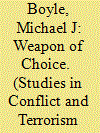

|
|
|
|
|
| Summary/Abstract |
Under what circumstances do armed groups in conflict choose to use terrorist bombings? This article challenges the conventional wisdom that terrorist bombings are done by either ideologically-driven or weak armed groups who have no reasonable prospect of success on the battlefield. Drawing from Mao’s theory of protracted struggle, it argues that terrorist bombings are a weapon of choice for armed groups that have transitioned into capable fighting armies but lack the degree of popular support they need to be a serious political contender. Using data on attributed terrorist bombings from 1998–2005, it finds that Islamist groups and older armed groups with sizeable membership are more likely to use terrorist bombings than smaller or newer groups.
|
|
|
|
|
|
|
|
|
|
|
|
|
|
|
|
|
|
|
|
|